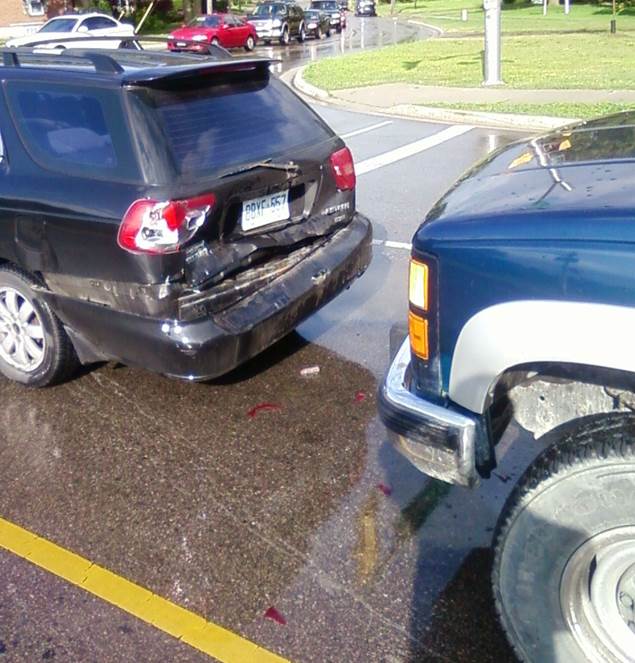 Raising kids does not have to be a financial disaster. Why? Because kids aren’t expensive. Parents make them expensive.
Raising kids does not have to be a financial disaster. Why? Because kids aren’t expensive. Parents make them expensive.
I’m not sure who coined that phrase. I’ve seen variations of it pop up all over the place. But one thing is absolutely certain: Raising kids costs more money than not raising kids. Simply put, there are more mouths to feed, more baths to fill, more bodies to clothe. Within that reality, though, you have nearly full control over the only variable that really matters, and that is how much more money it will take.
Kids aren’t expensive. Parents MAKE them expensive.
There are several “mainstream” articles that discuss how many hundreds of thousands of dollars it takes. And that may be true, assuming you want a huge house in a tony neighbourhood or you want to buy a big SUV to drive your kids 3 blocks to school instead of walking or biking. But today’s post is intended to provide a real-world example (us!) of finding some happy middle ground.
To be fair, we’ve made our share of mistakes in the past and at times fallen prey to Ivy League Preschool Syndrome, but hopefully we’ve learned our lessons and can help you avoid the same consumer traps.
Here are the categories I’ll cover today. There is obviously a ton to say on each of them, so if you’d like more detailed info, drop me a line or ask in the comments. Now let’s dive in!
Baby Gear
I’m going to start with baby gear. This is stuff like car seats, strollers, cribs, playpens, exer-saucers, bottles, Diaper Genies, change tables, baby gates, rocking/gliding chairs, bike trailers, diaper bags, swings, high chairs, bassinets, playsets, infant gyms, baby baths, mattresses, and so on. Phewf!
Hopefully you can catch a bit of the irony and sarcasm in that last paragraph. Some of those items are absolutely essential whereas several are simply “wants”. Can you tell the difference? More specifically, even if you decide that something is a want instead of a need (like a fancy-pants motorized swing to keep Baby quiet), do you need to have the all-bells-and-whistles version from the high-end big box baby gear store? Or are there are more efficient, alternative methods?
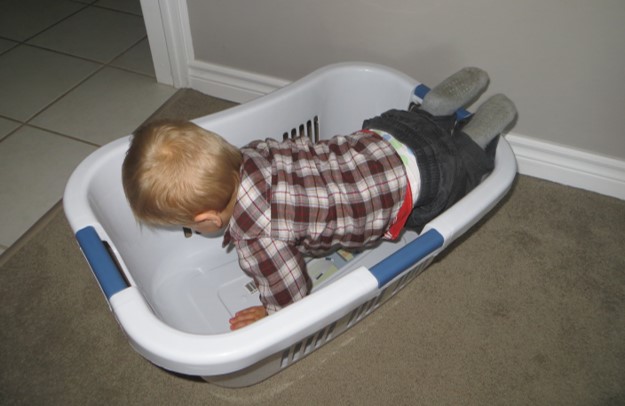
Who needs a fancy playset when you have a spare laundry basket?
Let’s take that swing as an example. For our first child, we got a wind-up swing off Kijiji (aka Craigslist for Canadians) for about $15 or $20, and later sold it for a similar amount. Score! Really? Not really. We learned that it didn’t swing long enough between wind-ups (just a few minutes) and had poor speed control. So for our second son, we “had to have” that motorized swing. My wife scoured the internet, found a new one on sale from the US, had it shipped to Port Huron where we picked it up on an semi-related trip to Sarnia. After using it for a few months, she sold it on Kijiji for within a few bucks of what we paid.
Ok, but what about safety-specific gear that legally needs to be purchased in Canada, like car seats? Here we did buy new (timing the sales, of course), and did our research on what would work for us. I think we ended up spending something like $400 on a travel system (infant car seat + stroller). At first that seems like a lot, but we know of many folks who spent double that because they “had to have” the “look at me” stroller set. And to be fair, we also bought a “look at me” stroller later on. But we bought it used and sold it when we were done with it. I even wrote about it over here.
In my opinion, the only thing that would justify spending that kind of cash on a high-end set would be if it’s an ultra-compact set and it lets you get away with owning a smaller car! Read on for my thoughts on that one…
The bottom line with baby gear is like everything else: Figure out what you really need, not what The Joneses say you need. Shop around for great sales and used items, take care of the items, and then resell them when you’re done.
Housing
I recently read about a lady who, a year ago, planned on spending $500-600k to buy a new house but then proceeded to stand in line for 3 hrs to spend $955k instead! Why? Because she was “rushed” and wanted a nice place to raise her young son. (What part of “rushed” happens when you’re standing around for that long waiting…?) Now, to be fair, there are a LOT of other things going on in that article, but my point is that you simply do not need to spend $1M or so for a nice home to raise a family. And you most certainly better not make the decision based entirely on emotions!
In many cities of the world, people raise families in 2- or sometimes 3-bedroom apartments without issue. Others decide that they want a yard, so they move to the suburbs and commit to a nerve-wracking 45- to 60-minute commute each way, which of course results in having far less time to spend in said yard with said children. If neither option appeals to you, then move to another city. “But I can’t, because my family lives here and my job is here!” That’s fine – but recognize that that is your choice, and you must make that choice deliberately and live with the resulting outcomes. Remember, it’s your choice, so don’t blame anyone else. Put it all down on paper and figure out the best decision for your situation.
Another key point here is that many people (self included) decide that they “need” a bigger house with more bedrooms, yard, garage, etc. In other words, they “need” a McMansion. We felt that way a decade ago. Thankfully, prices here in London, Ontario were such that it was certainly affordable. (Prices are still affordable now, albeit a little less so.) There is definitely something nice to be said about having space to spread out, having privacy, and having nearby access to all sorts of great schools and other amenities.
But if I had to do it over again, knowing what I now know about home ownership and the totality of costs involved (this becomes truly apparent when you amortize the cost of roof, windows, furnace, etc. across your ownership period), I would certainly consider very strongly getting a smaller place closer to work. At this point and with our current path towards financial independence and what we want out of life, the transactional costs of moving would exceed the benefits. So we will stay put. Besides, we have GREAT neighbours and a GREAT micro-community!
Cars
Well, we messed up on this one, too, but are making what I hope is a graceful recovery.
It actually all started when we were re-ended when my wife was 7 months pregnant in 2010. We had no intentions of getting rid of our green 2002 Accord or 1999 Esteem (that little black Suzuki station wagon made us feel awesome…). But then some dude in a 3500 Chevy truck with a large trailer decided to slam into us. Fortunately, Andrea and Baby were fine and my injuries were minor, but the Esteem came to an untimely end. And thus began our hormone-clouded car shopping experience.
We did have time to shop without rushing. But somewhere in that shopping process we came to the conclusion that our car seat was too big for the Accord (what were we thinking!?) and we needed something bigger so we could haul Baby and all the gear that we thought we “needed”. And so we ended up with a 4-yr old 2006 CR-V.
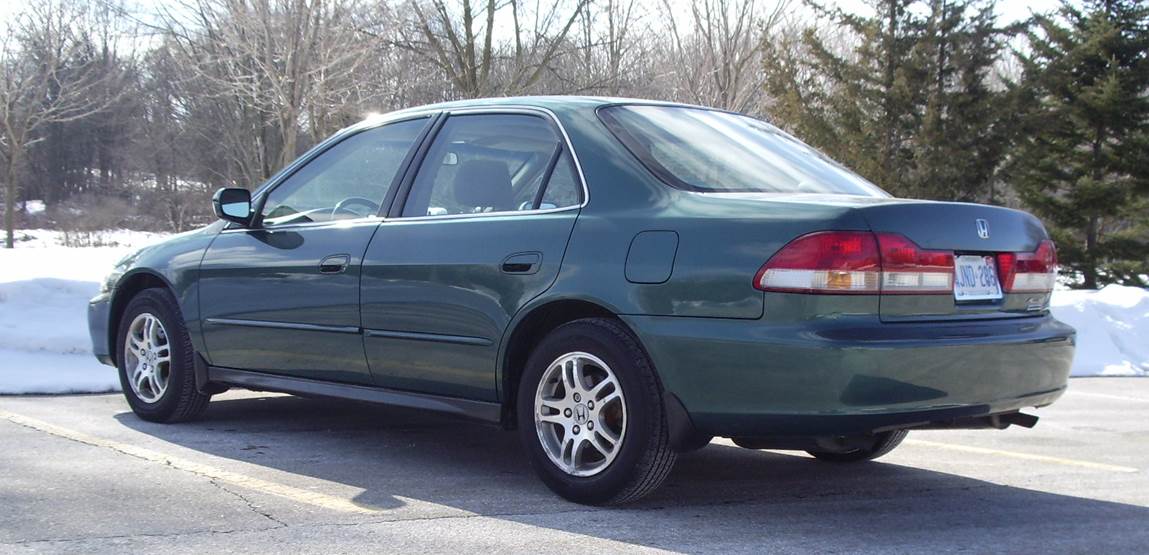
Since when did “family cars” become “too small” for families?
At least we bought privately for a great price and we still drive it to this day. It is a very solid, reliable vehicle that costs us little to operate. We certainly did not and do not need it, but selling it now would yield less than it is worth to us. So we accept the “want” of the ol’ CR-V. In other words, the Accord would have been just fine as a primary vehicle had we replaced the Esteem with a similar econobox. And for those rare times when we needed more space, a Tulle roof rack or small trailer would have done the trick nicely. And if it was really tight, we could have bought an $800 compact car seat / stroller travel set and called it a day.
I think we’ve learned our lesson, though, because when the Accord needed replacing a few years ago, we downsized to a Civic. Another great car for us, which we’ve even taken on many long road-trips!
Clothing
Kids go through a LOT of clothes. There’s no real way around it. We got lucky with two boys (two girls would have been just as lucky) because we often get double-usage out of most items.
My wife owns this department in our household, so I don’t have much to say here. She does the mom-to-mom sales (both buying and selling), finds the Kijiji deals, does the price-matching, fixes up ripped clothes, and shops online with Ebates, etc.
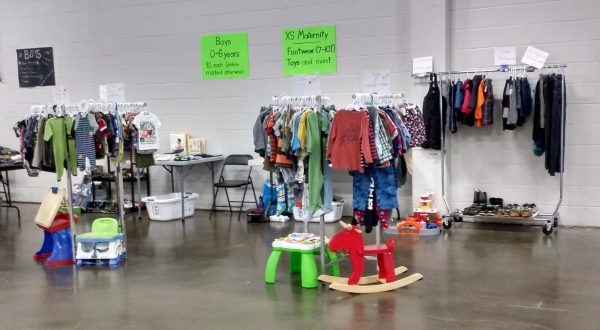
Buying and selling used clothing and toys is a great way to keep costs down and recoup a few hundred bucks!
Her biggest secret, though, is buying the kids’ wardrobes almost about 8 or 9 months ahead of time. This way she catches this year’s end-of-season sales for next year’s clothes.
Of course, there is a risk that the kids will grow faster or slower than anticipated, but generally speaking we’ve had a lot of success with this approach. And if not, well she gets the items at such discounts that she can resell them (“brand new with tags!”) for about the same price.
The only other thing to keep in mind is one of my common refrains: whenever you’re buying an article of clothing, and in particular low-usage items like fancy shoes and dresses, be sure to think it through carefully and not just follow the herd.
Groceries
Just for clarity, our “grocery” category also includes toiletries, hair-care products, and diapers. We don’t split up kid food vs. grown-up food. Also, as members of the PC Plus (and now PC Optimum) rewards, we earn a substantial amount of free groceries. But we back that out of our calculations to figure out what we actually would have been spending without the rewards.
And here it is for our entire family, pretending that we paid for the free stuff from grocery rewards:
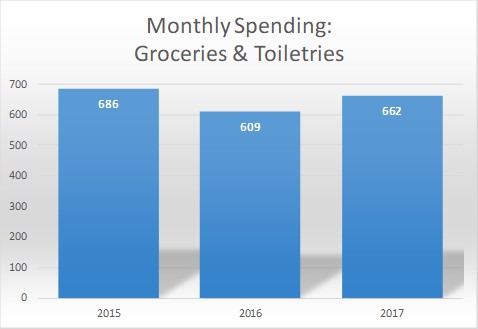
Without diving into the details and breaking it down even further (I’m trying to avoid analysis paralysis!), I would guess that the drop from 2015 to 2016 was largely due to a reduction in diaper purchases. The subsequent increase in 2017 was probably connected to healthier eating combined with growing appetites. (Our boys eat a LOT!)
But I do happen to have a bunch of data that can shed some additional light. Check this out:
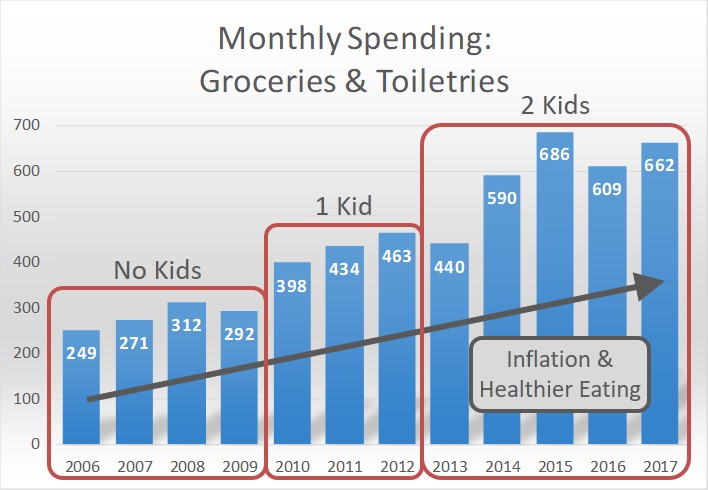
First, I can’t believe we spent less than $250/mo on groceries in 2006! (And perhaps you can’t believe how or why I even know that…) But we can see the increases due to three things: inflation, healthier (read: more expensive) eating, and kids. I also don’t think that the values prior to 2015 have “free groceries” added back in. It’s also interesting to note that the big jump after kid #2 occurs in the second year, which emphasizes the inflation and healthier eating trends. In general, though, it looks like our kids each add about $150/mo to our monthly grocery & toiletries bill (including diapers). Let see if we can hold that line as their legs hollow out.
Even though groceries are among our highest spending categories, I’m convinced that we’re doing well overall here. One of the ways we keep costs low is by shopping the sales. Again, my wife rocks this department. But we also keep away from expensive, processed junk food and kids’ snacks most of the time. There are far tastier and healthier snacks out there for less money, such as homemade cookies, yogurt or fruit.
What could be better than healthier and cheaper? (Ok, lots of things, but you get the point!)
Activities and Recreation
So many folks enroll their kids in a million different activities. When I wrote out the list of stuff I would like them to do, I used up all of the ink in my pen… So we’ve made deliberate choices to not overburden our kids with activities and instead build what we think is a healthy mix of structured activities and unstructured play time. This has the added benefit of building in more family time, being less rushed, and of course lowering expenses.
Here’s what we do that costs money:
Swimming:
- City-run swimming lessons for each kid (only for half of the terms throughout the fall and winter)
- Membership in our local community swimming pool in the summer
- No equipment needed because they would have bathing suits even without swimming lessons
Music:
- Piano lessons with our neighbour; in our case, our neighbour gives us free lessons but we would pay for lessons if this were not the case (she won’t accept payment, no matter how hard we try! …but we attempt to make up for it in other ways…)
- Yes, we chose to buy a digital piano at Costco that hopefully will last a few decades; there are also many low-cost used pianos and keyboards for sale
Team Sports:
- Soccer for one kid and tee-ball for the other through the spring/summer, based on their preferences (just tonight we decided one night of soccer per week for $95 instead of two nights for $120; sure, the latter is a better deal per hour of soccer, but we need some free time to let kids be kids!)
- Equipment requirements are very low here, and can usually be found used or sold afterwards
Skating:
- The city has several timeslots where parents or families can skate indoors for free, so we started teaching our kids this fall
- We bought the two helmets and two pairs of skates used, and hopefully will recoup most of those costs as we trade up during growth spurts
- If the boys develop an interest in hockey, then they can play on the outdoor rink down the street with the other neighbourhood kids
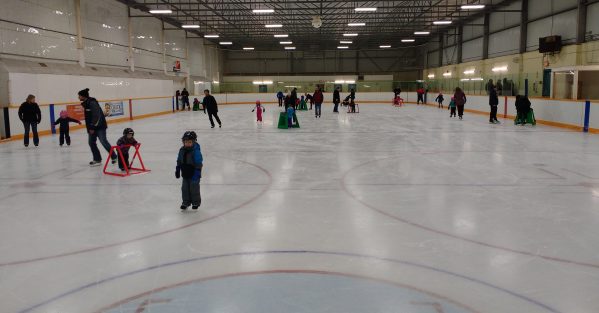
We’re not the only family to take advantage of free skating every week.
We also do other fun family things like biking (but again, they would have bikes regardless), hikes, and the occasional mini-golf (great birthday and Christmas gifts ideas instead of “more stuff”).
None of these are particularly expensive, and we spread them out as best we can. On average, it works out to a total of about two “things” each week that we have committed to, depending on the time of year. For us this is a nice balance between family time, kids’ exposure, and reasonable costs.
Education
A few months ago I had the shock of my life when I checked out the tuition costs for a Canadian university degree in a profession program like Engineering. Wow! So does that mean that you need to mortgage your house to put your kids through post-secondary school? Uh… no.
There are many alternatives to selling your retirement or leaving your kids saddled with debt.
You certainly can and probably should save some cash along the way. If your family is in a high income bracket (anything above around $80k/year), you should have no problem maxing out your kids’ registered education savings plans (RESPs) if you spend wisely on other things. And if you’re in a low income bracket, you’re getting substantial Trudeau Bucks (sorry, “Canada Child Benefits”) that you can sock away.
Also, I’ve heard that Ontario has introduced new grant programs for “low income” families that cover a large amount of the cost of post-secondary education, but I have not confirmed the details on how the program works. Of course, you can always have your kids live at home for a few years if you live near a college or university. Obviously don’t forget that your kids should work to at least a certain degree to help pay as they go along! Co-op education programs and internships can be great for this. And finally, not everybody can or should attend college or university. There is definitely demand for skilled trades via apprenticeship programs.
Regardless of the approach you decide on, there’s one more very important aspect: You need (and this is a real need) to instill upon your kids the importance of making wise, well-thought out, deliberate decisions, which includes being wise with their finances. For example, just cutting back one night per week at a restaurant or party throughout a 4-year degree will save them about $50 x 52 weeks x 3.5 years = $9100 (plus compound interest). That’s a lot of cash! Be smart with it, and teach your kids to do the same.

University of Waterloo Tuition, Feb 2018 – Ouch! https://uwaterloo.ca/future-students/financing/tuition (At least they offer co-op education…)
Jump to: Top – Outline
Childcare
Warning, warning, danger, danger! This one’s a hot topic!
There is no doubt that childcare is very expensive. In London it runs on the order of $50/day, but that varies based on the type of care, age of the child, how many days per week you buy, etc. So the suggestion here is to simply NOT put your kids in childcare.
What?
Yeah. Take the time with your kids instead. Work part-time from home. Step out of the labour force for a few years. In other words, become a single-income family.
What?
So many people think that you need to have two incomes. Well, that’s probably only the case if you’re insistent on keeping up with the Joneses and can’t control your own spending. Remember, you don’t need even half of the things you think need.
You don’t need even half of the things you think need.
It’s also possible that you have a low income job and actually do need that second income. But chances are that your low income job is paying only for childcare, and nothing else. If you are in a low income scenario, you need to take clear steps to enhance your employability. Ask for help. Get support from a community organization. Go back to school. Learn a new trade. Start a small business. It’s apparently easier and cheaper than you might think! These are all decisions that only you can make.
Ok, so let’s say you forgo childcare and become a stay-at-home parent. Yes, you could consider the opportunity cost of lost income as a cost of raising kids. But you could also consider it the opportunity of raising kids! Why do you even have kids if you don’t want to raise them?
In Conclusion…
Given the nature of raising kids and the multitude of approaches, environments and situations we all find ourselves in, with any luck you will have at least picked up some common themes here. My hope is that we can all lead happier, healthier lifestyles with time to spend doing what we love, and alongside the people we love.
So be deliberate with your choices. Shop the sales and used item markets. Don’t try to keep up with the Joneses. Focus on doing what is best for your family and build the time into your schedule to make it happen.
 Your Turn Now!
Your Turn Now!
What mistakes have you made buying unnecessary stuff for your kids? Any other ideas or suggestions you’d like to share? And most importantly, what are you going to do differently moving ahead?

 Your Turn Now!
Your Turn Now!





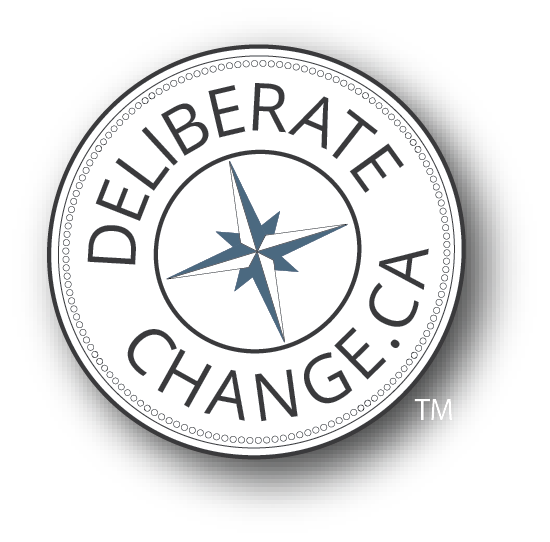

I think the biggest factors are housing and childcare. We live in a 2 bedroom condo and it was perfect for a couple. After we had a kid, it’s still okay. Now my mom is living with us and it is really tight. We need to move to a bigger place soon. Kids need more space.
Childcare is very expensive here as in many other big cities. Our kid is going to public school now so it’s much easier on our budget.
Other than these 2, I think a child isn’t that expensive. Maybe when he’s a bit older and want to buy more expensive stuff. I’m glad we had our kid, though.
Hi Joe,
That’s a good point about kids needing space. One thing to add to that would be outdoor space to run around and get plenty of exercise. That could be a large yard or a public park or both.
“I’m glad we had our kid, though.” Agreed! Life isn’t all about money 🙂
I find that as our children get older, it’s the sports/music costs that can start adding up. We keep costs reasonable, but I am always in shock when I speak to other parents who have their kids in rep level hockey and tennis. Their costs can add up to the tens of thousand of dollars/yr!
That’s a crazy amount, but I believe it! We’re starting to see those costs climbing a bit too. This will be the last summer our older son gets to play “cheap” baseball. He’ll move up an age level next year where the costs are close to double this year…. sigh. At least it’s not hockey! 🙂